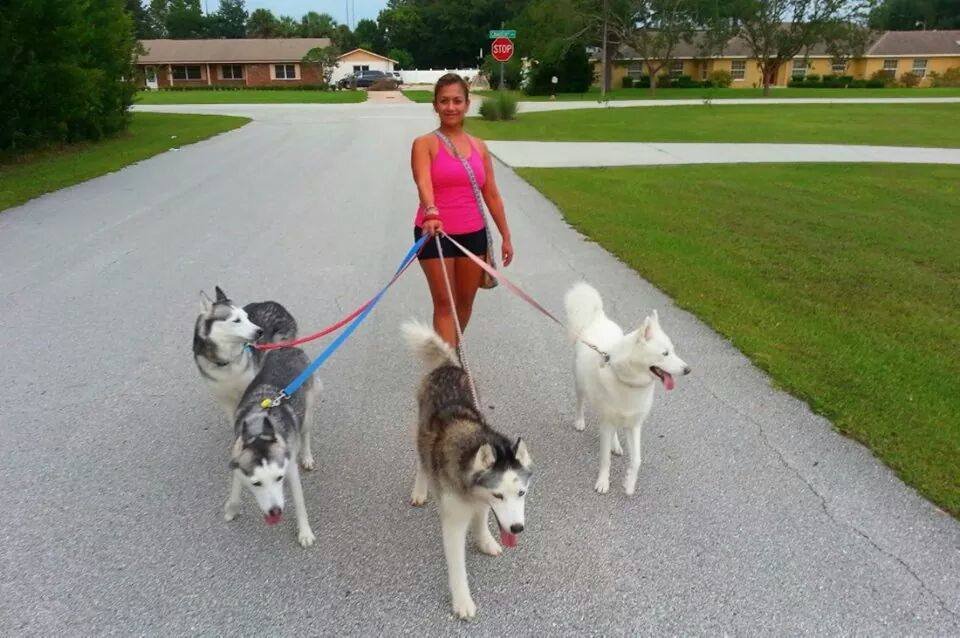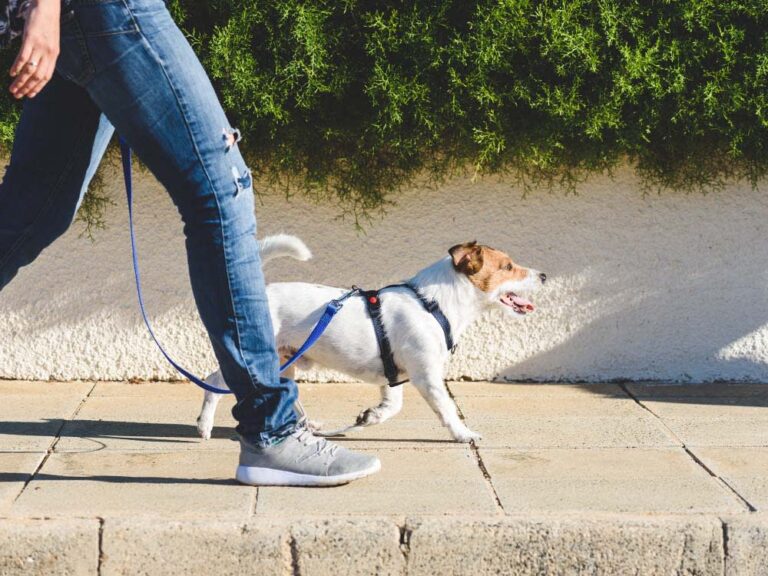To get a dog to walk on a leash, reward them with a friendly word or small treat when they pause and look at you instead of pulling. Stay still until they stop pulling, then move in the correct direction to guide them properly.
This positive reinforcement technique helps train the dog to walk without pulling. Additionally, holding treats in your hand while walking and saying “Let’s go!” In a cheerful voice can also encourage them to walk on a leash. With consistent training, dogs can learn to walk on a leash within a month, but it is important to be patient and consistent during the training process.

Credit: www.reddit.com
Understanding Leash Training
Leash training is an essential skill that every dog should master. Not only does it make walks more enjoyable for both you and your furry friend, but it also ensures their safety and the safety of others. Understanding leash training involves recognizing the importance of proper training, being aware of common challenges, and knowing the keys to successful leash training. Let’s delve deeper into each of these aspects.
Importance Of Leash Training
Leash training is crucial for several reasons. Firstly, it allows you to have control over your dog’s movements, preventing them from running into dangerous situations or getting lost. Secondly, it helps instill good behavior, teaching your dog to walk calmly without pulling. Lastly, it promotes a strong bond between you and your furry companion, as training sessions are an opportunity for quality time and positive reinforcement.
Common Challenges In Leash Training
Leash training can present some challenges, but with patience and consistency, they can be overcome. One common challenge is pulling, where your dog tugs on the leash, making walks uncomfortable and strenuous. Another challenge is distractions, as dogs are naturally curious and may be tempted to chase after squirrels, other dogs, or even cars. Lastly, some dogs may initially resist the leash, feeling restricted or uncomfortable. Recognizing these challenges is the first step towards addressing them effectively.
Keys To Successful Leash Training
To ensure successful leash training, there are several key strategies to keep in mind. Firstly, start with the right equipment – choose a sturdy leash and an appropriate collar or harness that fits your dog comfortably. Secondly, introduce your dog to the leash gradually, allowing them to sniff and explore it before attaching it to their collar or harness. This helps them form positive associations with the leash. Thirdly, use positive reinforcement techniques such as treats, praise, and petting to reward your dog for walking calmly by your side. Remember to be consistent and patient, understanding that every dog learns at their own pace.
- Start with the right equipment
- Introduce the leash gradually
- Use positive reinforcement techniques
- Be consistent and patient
By following these key steps, you can make the leash training process more enjoyable and effective for both you and your furry friend. Remember, leash training is a skill that requires time and effort, but the benefits of having a well-behaved and obedient dog are well worth it.

Credit: www.huskyhavenfl.org
Techniques For Leash Training
To get a stubborn dog to walk on a leash, try standing still when they pull and reward them with a treat or kind word when they pause. Gradually reduce the rate of rewards as they improve.
Positive Reinforcement
In order to teach your dog to walk on a leash, positive reinforcement is key. This means rewarding your dog for desired behavior, such as walking calmly beside you without pulling. When your dog walks nicely on the leash, be sure to offer verbal praise, petting, or a small treat as a reward. Positive reinforcement helps your dog associate good behavior with positive outcomes, making them more likely to repeat the behavior in the future.
Using Treats Effectively
Treats can be a powerful tool when it comes to leash training. Be sure to choose small, soft, and highly desirable treats that your dog will be motivated to work for. When you start your walk, hold a treat in your hand and use it to guide your dog’s attention and behavior. For example, hold the treat in front of your dog’s nose and let them follow it as you walk. Be sure to reward your dog with the treat when they walk calmly beside you without pulling.
Handling Distractions
Distractions can make leash training challenging, but it’s important to address them appropriately. When your dog gets distracted and pulls towards something, such as another dog or a squirrel, it’s crucial that you stay calm and patient. Instead of allowing your dog to advance towards the distraction, stand still and do not let them move forward. Wait for your dog to look at you or resume walking calmly beside you before proceeding. When they do, reward them with praise or a treat to reinforce the desired behavior.
Ensuring a successful leash training experience requires consistency and patience. Remember to always use positive reinforcement, effectively use treats as rewards, and handle distractions calmly. With time and practice, your dog will learn to walk on a leash with ease and enjoy going for walks together. Happy training!
Tips For Troubleshooting
To get a stubborn dog to walk on a leash, stand still when they pull and reward them for pausing. Stay consistent and gradually reduce the frequency of reinforcement as they improve.
Dealing With A Stubborn Dog
If you have a stubborn dog who refuses to walk on a leash, it can be frustrating. However, it is important to remain calm and patient throughout the training process. Remember that dogs respond best to positive reinforcement and consistency.
Patience And Consistency
When dealing with a stubborn dog, it is crucial to have patience and consistency in your training approach. Use positive reinforcement techniques, such as treats and praise, to reward your dog when they exhibit the desired behavior of walking on a leash without pulling. Consistently reinforce this behavior every time you go for a walk, and gradually increase the duration and distance of the walks.
Gradual Progress And Setbacks
Teaching a dog to walk on a leash takes time and effort. It is important to remember that progress may be gradual and setbacks may occur along the way. Be patient with your dog and celebrate small victories. If you encounter setbacks, such as your dog reverting back to pulling on the leash, simply go back to the previous step in the training process and reinforce the desired behavior.

Credit: www.reddit.com
Frequently Asked Questions Of How To Get A Dog To Walk On A Leash
How Do I Get My Stubborn Dog To Walk On A Leash?
To get your stubborn dog to walk on a leash, stand still when they pull and don’t let them move forward. When they stop and look at you, reward them with a word or treat. Stay still if they start pulling again, and only move when they stop.
Consistent training is key.
How Do You Train A Dog To Walk On A Leash?
To train a dog to walk on a leash: 1. Hold the leash on the same side as your dog, with tasty treats hidden in your other hand. 2. Say “Let’s go!” In a cheerful voice and start walking. 3. Reward your dog with treats and praise when they walk nicely on the leash.
4. Gradually reduce treats as your dog improves. 5. Be patient, as it may take about a month for puppies and longer for older dogs to fully learn.
How Long Does It Take For Dog To Learn To Walk On Leash?
On average, it takes about a month to fully leash train a dog, including puppies. However, be aware of the “teenage” phase that dogs go through around nine months old, as it may affect their leash training progress. Consistent training and positive reinforcement are key.
How Do I Stop My Dog From Pulling When I Walk On A Leash?
To stop your dog from pulling on a leash, stand still when they pull and reward them when they pause or look at you. Stay still until they stop pulling again before moving forward. Train your dog to walk on a leash by holding treats and saying “Let’s go!” Gradually reducing treats over time.
It can take about a month for puppies to be fully leash-trained.
Conclusion
To successfully get your dog to walk on a leash, it’s important to be patient and consistent. Remember to reward your dog with treats and praise when they display the desired behavior, and stay calm and firm when they pull or get distracted.
With practice and repetition, your furry friend will learn to walk on a leash like a pro. So put on that leash, head outside, and enjoy your walks together! Happy walking!



